
Aiming for more than $42,000 in prizes, young U of T entrepreneurs pitching to investors packed their presentations with 3D animations, live classical guitar serenades, product giveaways hidden under audience chairs – and one very efficient mop bucket.
Welcome to demo night at the Entrepreneurship Hatchery, U of T Engineering’s startup incubator, where 13 companies competed for backing. The top prize was an investment of $20,000: the Lacavera Prize, sponsored by alumnus and CEO of Wind Mobile, Tony Lacavera (CompE 9T7).
The 13 presenting teams were chosen out of 37 groups that participated in the Hatchery’s concept development program over the summer. Each company included at least one engineering student, but they also drew members from a mix of backgrounds including biology, computer science and environmental science.
The students had developed their ideas and business models during four months of intense industry mentorship, entrepreneurship skills growth and engagement with Engineering’s equipment and resources. Finally, on September 11, each team hovered at the back of a room of judges and audience members for their big demo night – jumpy and primed to fight for real funding.
“This is an example of passion, dedication and entrepreneurship and this is exactly what the Hatchery is about,” said Hatchery director Joseph Orozco, gesturing to the crowd of students at the back. “Those entrepreneurial skills that you guys have been developing will stay for life with you.”
The result was more than a dozen slickly presented pitches that made a case for a $20,000 injection into their business. Each company contended for a product or service more surprising and genuinely useful than the last. For starters, how about mop wringing?
After welcome remarks from Orozco and Hatchery advisor Joseph Paradi (ChemE, MIE), the first company to compete for the Lacavera investment strode onto the stage – pushing the mop bucket.
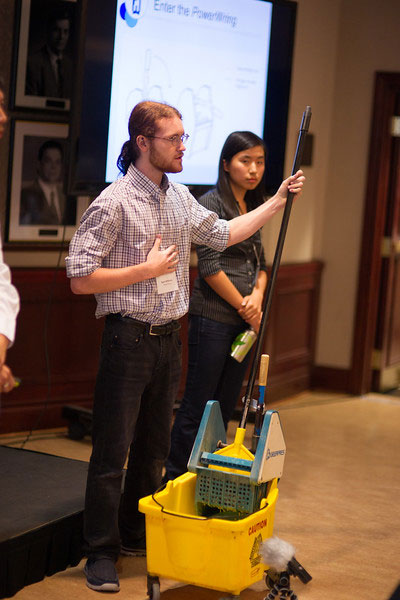 What followed was a clear description and demonstration of a product called Power Wring. The mop’s business model was founded on small and affordable add-on mop wringers that could save time and preserve the neck- and back-health of tens of thousands of caretaking staff across Canada and beyond. They’d already validated their concept with feedback from U of T’s caretaking department, which signed on as Power Wring’s first customer.
What followed was a clear description and demonstration of a product called Power Wring. The mop’s business model was founded on small and affordable add-on mop wringers that could save time and preserve the neck- and back-health of tens of thousands of caretaking staff across Canada and beyond. They’d already validated their concept with feedback from U of T’s caretaking department, which signed on as Power Wring’s first customer.
In each of the five-minute pitches that followed, the same format was echoed: problem, solution, market projection and comparisons, validation, business model and team introductions. The Hatchery-trained entrepreneurs brought forth businesses grounded in their unique hacks of a broad swath of real-world issues, including medical diagnostics (AccSYS Diagnostics), content marketing (Dabble), hydrogen-fueled vehicles (Hydron), breathable outerwear (Delta Outerwear) and more.
But then there were the extras. To set them apart as more memorable, more real or more quirky than the rest of the pack – and to make them stand out in the minds of the judges – some companies included special elements in their presentations. At times, the demos resembled a Dragons Den-style hybrid of investment showcase and performance-based entertainment.
Mech Minds, a company vying for an investment in its innovative grocery store checkout system, created a virtual supermarket on stage, scanned cans of coffee and boxes of ice cream with their device.
Savvy (pictured), a company developing a new way to connect fashion retailers with customers, cast team members in a theatrical simulation of the Eaton Centre.
Konnectivity presented its networking app with all members dressed in tuxedos, and closed the presentation with a classical guitar performance. Oonbox, a 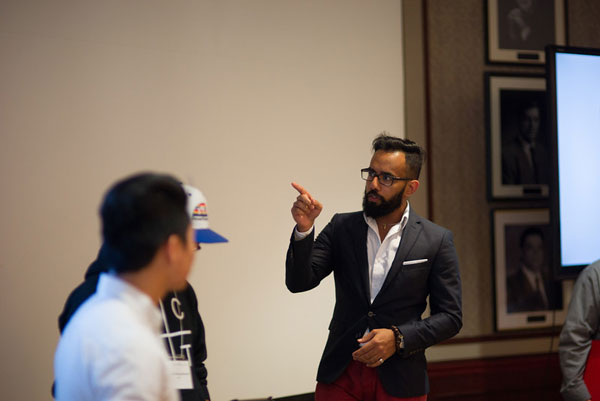 business communications software company, tucked business cards loaded with token credits for their system under each audience member’s chair. And Shour, a company that installed its ‘smart’ showerhead system on stage, leveraged a running joke about one of their co-founders’ distaste for bathing to get the audience on its side with humour and personal connection.
business communications software company, tucked business cards loaded with token credits for their system under each audience member’s chair. And Shour, a company that installed its ‘smart’ showerhead system on stage, leveraged a running joke about one of their co-founders’ distaste for bathing to get the audience on its side with humour and personal connection.
But the companies that came away with the evening’s prizes needed only to present their facts.
Judges awarded the $2,500 Orozco prize to Power Wring, the mop gadget, and one of two $10,000 prizes to LoftShare, a company developing software to streamline the roommate search, housing rental, lease application and negotiation, and rent payment process. (It’s already started to experience a buzz around Toronto after launching only the first portion of its plan – the roommate pairing service). And Pheedloop, which developed speaker and conference feedback software already in use by a professional client in the U.K., took the other $10,000 investment.
The main event, the $20,000 Lacavera Prize, went to FuelWear, a company that already launched its concept on crowdfunding platform IndieGoGo and beat its target for investment in just six days.
FuelWear offers “the first smart heated base layer” for users looking to stay warm for up to five hours as they ski, hike, or just try to walk to the grocery store in the midst of a polar vortex. (Read more about FuelWear)
Judy Paradi, adjunct Engineering professor, taught FuelWear co-founders Alex Huang (ElecE 1T3 + PEY) and Jason Yakimovich (CompE 1T3 + PEY) in a fourth-year entrepreneurship course at the Faculty of Applied Science & Engineering. She gave a visible start when the news was announced and the audience hollered and cheered.
“I’m so happy for them; they were fantastic students,” said Paradi. “A lot of kids enter the class and they don’t really know if they want to be entrepreneurs, but you could tell right from the beginning, they were serious.”
“They started with a coat that didn’t make any sense, but we worked through various iterations and they were totally committed. I’m so pleased for them, I couldn’t be happier.”

Molly Shoichet (ChemE, IBBME), the world-renowned expert in tissue engineering and regenerative medicine, is the U of T President Meric Gertler’s new senior advisor on science and engineering engagement.
Shoichet, who says she has been fascinated by science since she was six years old, hopes to motivate the next generation to pursue careers in science, technology, engineering and math.
“It is the ‘geeks’ who change the world,” said Shoichet, about the message she wants to tell young people. “Embrace the geek in you, make a difference and tell people about it.”
In her new role, Shoichet will collaborate with U of T colleagues to communicate the excitement of their discoveries with the public. U of T’s science engagement initiatives include building partnerships for delivering science outreach programs; highlighting ongoing U of T lectures and public events; and coordinating a wide range of professional development and leadership opportunities, including an annual Science Leadership program for faculty members offered in April 2015, and a science journalism course for graduate students taught by Globe and Mail science writer Ivan Semeniuk.
“The goal is to bring people who are curious and engaged in the community into our world, and raise their awareness of the fantastic work being done at the University of Toronto – and across Canada,” said Shoichet.
Through her new role, Shoichet will support the upcoming Science Literacy Week at U of T, which takes place September 22–28. Spearheaded by alumnus Jesse Hildebrand and U of T Libraries – and in collaboration with the Toronto Public Library and York University – Science Literacy Week is a city-wide event that offers public access to documentary screenings, book displays and lectures, among other offerings, to showcase the field of science in its many forms.
“Science Literacy Week is a wonderful way to engage the Toronto public and U of T community in the wonders of science,” said Shoichet.
Internationally regarded for her lab’s groundbreaking research, Shoichet is a member of the Order of Ontario and holds the distinction as the only person to be a Fellow of Canada’s three national academies: the Royal Society of Canada, the Canadian Academy of Engineering and the Canadian Academy of Health Sciences.
A University Professor – U of T’s most distinguished rank – Shoichet holds a Tier 1 Canada Research Chair in Tissue Engineering, and is a professor in both the Institute for Biomaterials and Biomedical Engineering (IBBME) and the Department of Chemical Engineering & Applied Chemistry (ChemE). Her work focuses on polymers for drug delivery and regeneration – materials that promote healing in the body.
Shoichet currently leads a multidisciplinary team of researchers working on a range of projects, from approaches to brain and spinal cord regeneration to new drug delivery methods for treating cancer. She has published more than 400 papers, patents and abstracts and founded two spin-off companies from her research.
“I am delighted and grateful that Professor Shoichet has taken on this new responsibility,” said President Gertler. “She brings to the position immense talent and accomplishment, not only as a world-renowned scientist and innovator, but also as a teacher, mentor, and communicator. She is also a leading public-policy advisor on science, technology, and innovation.
“Science literacy is one of the core competencies we need, to advance our shared prosperity and to help build a happier, better world. Molly Shoichet is a powerful advocate of this crucial cause.”
With files from Liz Do
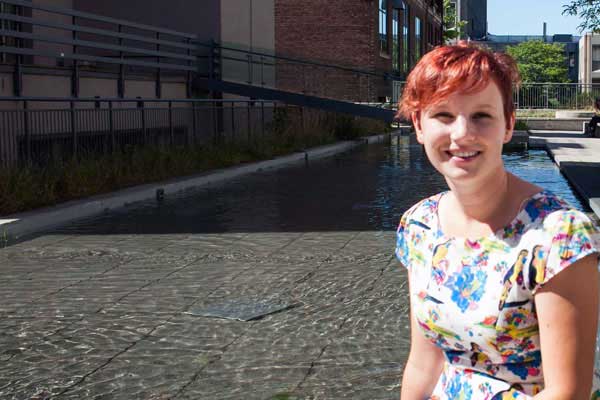
The University of Toronto is home to many experts who study how cities can be improved. One aspect of cities that may be taken for granted is one of the most important: water supply.
At U of T, water conservation efforts have been underway since the 1970s. For example, underground cisterns on the downtown campus collect rainwater, which is then used by a smart irrigation system that only waters lawns if there is no rain in the forecast. But as cities continue to grow, so does the need for everyone to protect and manage water resources.
Enter Professor Jennifer Drake (CivE), an expert in water security.
Drake’s research expertise includes stormwater systems, watershed planning and stormwater management. She’s especially passionate about building and managing urban water systems that minimize the impact on the natural environment.
The increasing frequency of extreme weather events such as droughts and floods is drawing attention to Drake’s research and the challenges and opportunities of protecting urban water resources in the 21st century.
U of T writer Dominic Ali spoke with Drake about the importance of water for cities in the 21st century.
Why is water management so important?
We only have a finite amount of water and it is cycled in the environment over and over again. This means that no matter where you are, the water in the natural environment will be used by someone for drinking, irrigation, recreation, etc. Water security includes issues of availability and water quality.
My research focuses on issues of quantity such as flooding (i.e., protecting us from when there is too much water) and quality such as developing new technologies to improve the quantity of urban runoff before it is returned to a natural system like a creek or lake.
Canada’s infrastructure deficit is estimated at $123 billion of which $31 billion is for water/wastewater. Improvements to water infrastructure are critical to the Canadian economy. Moreover, when we invest in our water resources and foster healthy aquatic environments we make our cities more liveable and create opportunities for residents to experience the beauty and peace of the natural environment.
Why is low-impact development seen as better for water management?
Our water resources are much more resilient and secure when we work with nature instead of against it. For example, if you live in the U.S. southwest, a region of water scarcity, your lawn should be landscaped with drought-resistant plants, not turf grass. In Ontario, low-impact development practices aim to restore the hydrology that is often lost as a result of urbanization. This is achieved through innovative technologies like green roofs, bioretention systems and permeable pavements.
What are some of the water challenges faced by cities?
One of the biggest challenges facing cities like Toronto is the uncertainty regarding water availability in the future. All of our economic and social systems depend on reliable source waters (groundwater, lakes, rivers and streams) with sufficient quantity and quality. Not only do we require water for drinking and recreation but all agricultural, manufacturing and resource-based industries require secure water supplies, too.
Climate change will alter the availability of water at local and national levels. Cities need to invest in infrastructure, which improves our resilience during extreme weather. In Ontario it is anticipated that climate change will change the type (snow vs. rain) and timing of precipitation. To adapt to climate change infrastructure investment, replacement and maintenance will be essential for cities. Some cities, such as Kitchener and Mississauga, are already adapting by developing new revenue mechanisms to support these costs.
With a Toronto election coming up, what question would you pose to the candidates about water security?
Toronto has implemented some very progressive programs such as the Green Roof Bylaw and the Mandatory Downspout Disconnection Program that are aimed at reducing flooding and improving water quality. However, despite these actions, flooding continues to affect Torontonians quite regularly.
From the mayoral candidates I would like to know what programs they would advance to continue reducing the occurrence of flooding within the city and minimizing the impact of flooding on Torontonians.
What first attracted you to this field?
I first became interested in urban water management and water security as an undergraduate student during a summer co-op placement with the City of Burlington. I observed first-hand the challenges associated with managing water infrastructure. This inspired me to ultimately research water security.
One of my tasks was to research maintenance costs for stormwater management pond cleaning. I was amazed to discover that, at the time, Ontario’s municipalities had invested in ponds for flood and water quality control but did not have sufficient funds to conduct the cleaning projects that need to be completed every 10 to 15 years.
This issue became even more compelling when I realized that a mid-sized Ontario municipality may operate 50 to 100 ponds and a single cleaning project could cost over $500,000.
Are any cities doing innovative things to improve water security?
There are a surprising number of success stories. Las Vegas, a city more famous for excess than conservation, is a great example. While the population of Las Vegas has tripled over the last 20 years, its per capita water use has dropped by 31 per cent. This means that the total water used today is almost the same as it was 20 years ago. Las Vegas has achieved this through changing water rates, supporting conservation and investing the infrastructure to allow for water re-use.

According to Shums Kassam (EngSci 1T5), a U of T Engineering degree equips students with many valuable things, but a solid fashion sense isn’t necessarily one of them.
Two things, among others, that Kassam claims he has gained from his engineering degree are both the competencies to build a digital personal stylist app called Blynk, as well as the connections that inspired him to launch it into a business, which is already seeing success on the market.
Kassam and fellow Blynk co-founder Jaclyn Ling designed their business around an app that combines user style preferences, instant purchases and the addictive swipe-right, swipe-left format.
“Through a Tinder-like interface, users swipe through inspiration photos – left to dislike, right to like,” said Kassam. “Blynk learns users’ style preferences and recommends a full outfit that users can buy based on what they like. Users also have the ability to build and share outfits, and even request outfits from fashion stylists – all for free.”
The duo developed Blynk both through U of T Engineering’s Entrepreneurship Hatchery and as part of the Next 36 entrepreneurship development program, co-founded by U of T’s Ajay Agrawal.
Since going through the Next 36, Kassam and Ling launched Blynk to great market and media interest, including features in Toronto Life, Global TV, the Globe and Mail and more. Kassam says the attention has been driven largely by the company’s entrepreneurial drive, as they’ve already pitched at industry showcases and even won a $100,000 investment for top spot in the International Startup Festival competition.
“Blynk’s vision is to provide free and accessible fashion advice to everyone,” he said, “through a simple, fun and addicting platform. An average personal stylist costs over $100 an hour. Blynk replicates this value for free, anytime and anywhere.”
Kassam spoke with U of T News about what’s next for the growing company.
It all started with a wardrobe problem
SK: Jaclyn and I arrived at this startup idea when she took me shopping early in December and gave me style suggestions. My confidence improved, and I really liked dressing better. We started working on Blynk in early April – developing it on Android while finishing up exams at school. Since then the startup has been going well. We won $100,000 from the International Startup festival and have had over 8,000 downloads while the app has been only out for about two months.
An app empowering fashion fans and fashion-challenged alike
SK: Blynk is for a variety of people – for someone like myself, I use Blynk because it helps me find products that I like and helps me define my own style. However, Blynk is also for fashion enthusiasts who want inspiration, or to share their love of fashion with others by posting content. Essentially, Blynk is for those who want to improve their style or those who enjoy expressing their style.
Blynk taps into the fashion blog community
SK: The fashion photos [featured on Blynk] come from different bloggers. We have partnered with a few fashion posts to upload content. In a newer version of Blynk [coming out within the next few weeks], users can upload their own content and, if approved, the content will be put in the feed. We are also planning, and already are starting, to partner with professional stylists. We continue to approve more stylists to our app.
Profits driven by users and vendors
SK: Many retail stores have contacted us because of interest in native advertising and in affiliate programs, where we can make a commission.
The real reason a fashion-challenged engineer devotes his time to a styling app
SK: I have a real passion for entrepreneurship – I see so much value in it, because it is a way to provide jobs and improve economic growth, while also trying to disrupt systems.
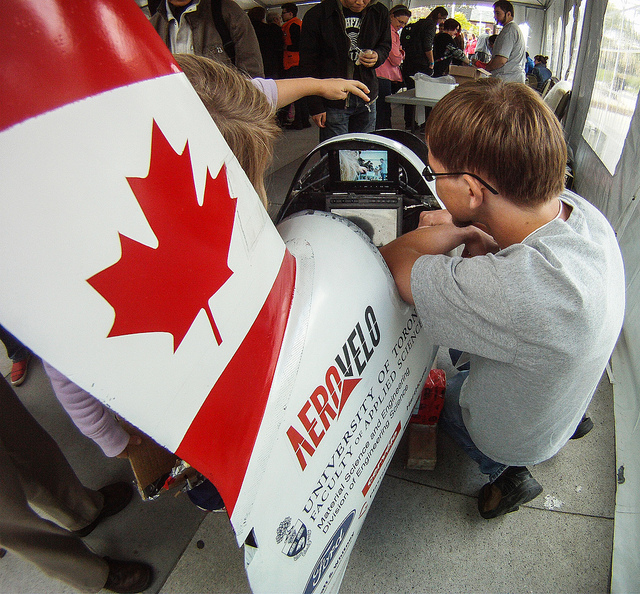
For anyone who makes anything – from R2D2 robots to DIY skateboards to 3D-printed chocolate sculptures and beyond – participating in the Maker Faire means entering into a worldwide family-friendly carnival of wondrous, inventive physical stuff.
Launched as a showcase of cool inventions from California’s Bay area in 2006, satellite Maker Faires have since popped up around the globe in locations like Kenya, Norway and Italy, with a second annual instalment hosting thousands of ‘makers’ in Toronto on November 22 and 23.
“We are looking forward to getting feedback from the community as well as seeing what’s out there from other local startups and makers,” said Michael Helander (EngSci 0T7, MSE PhD 1T2), co-founder of OTI Lumionics, a startup founded on U of T Engineering research innovations in organic LED lighting. “We strongly believe in the importance of building the local startup community and so we are delighted to be attending the Maker Faire in Toronto.”
Maker Faire debuted in Toronto last fall, gathering 4,000 makers of all ages and experience levels as they shared and experimented with a wild range of projects. Now, the Toronto team is raising the stakes, as they are set to present more than 100 exhibits – including the OTI Lumionics demo for their aerelight lamps – as well as a range of workshops and events in the Toronto Reference Library.
“Maker Faire is a unique opportunity to showcase inventions, meet fellow tinkerers and see the diverse maker crowd response to projects,” said Elena Yunusov, a co-organizer of Toronto Maker Faire and a digital communications strategist at U of T’s Faculty of Medicine.
“It’s important to give students an opportunity to play with technology, realize that everyone can make things and see that tinkering is a vital aspect of innovation and learning.”
Last year’s Faire drew U of T startups and students as attendees and exhibitors. Now, the call is for more university makers and audiences to join for the 2014 edition: the Toronto Maker Faire is accepting exhibitor applications until September 21, and offers free tickets for attendees online.
Yunusov offers three reasons U of T makers should submit their ideas for showcase, discussion and play at Toronto Maker Faire 2014:
1. Put your early-stage project into the hands of real users of all ages
EY: Last year, a startup named Battlegrounds put on an advanced laser tag game. After two years of design and testing, this was their first public demonstration and hundreds of kids got to play it. When a couple of their 3D-printed laser tag guns broke, the kids using them were upset they had broken something. The makers, on the other hand, were super happy because they finally knew what they needed to fix to make the equipment more durable. It was awesome because the kids were super surprised the makers were giving them bear hugs and gifts for breaking things!
2. Experience ideas of the future with your own eyes – and hands
EY: The Maker Faire is a great way to get inspired by all the amazing inventions that exist and to see it all first-hand – get a glimpse of the kind of future that is unevenly distributed.”
3. Build a business grounded in imagination
EY: The Maker Faire attracts entrepreneurs because they can showcase and prototype their inventions, develop new ideas, gauge public reaction and chat with other entrepreneurs. Many of the projects are crowdfunded, which is amazing to see.

First-year engineering student Quinton Lowe (EngSci 1T8) holds a black belt in karate, is a political advocate and is passionate about engineering. Now, he’s also one of two U of T students to receive the Schulich Leaders Scholarship, a prestigious $80,000 award started by business mogul and philanthropist Seymour Schulich.
Supporting 40 students annually across Canada, the scholarship rewards students pursuing undergraduate degrees in STEM (science, technology, engineering and math) who have demonstrated significant leadership qualities.
“Congratulations to Quinton Lowe for winning this prestigious award,” said Micah Stickel, Chair, First Year Engineering. “This recognition is a testament to the innovative thinkers and inspirational leaders our engineering programs attract.”
U of T’s Xarissa Thompson spoke with Lowe about the award and why he chose to study engineering at the University of Toronto.
What drew you to the University of Toronto – and why STEM?
I applied to the University of Toronto because I want the challenge and excitement of studying at the best engineering school in Canada. Top employers recognize the value of a U of T degree and I’ve heard news stories about the inventions and discoveries being made at this university. I also love Toronto and liked the idea of [living] downtown, where I could explore new things and have new experiences.
My interest in STEM courses really began in grade 11, when my courses started to focus on the specific sciences. I took a physics course that I really enjoyed and started to feel a pull towards a career in science.
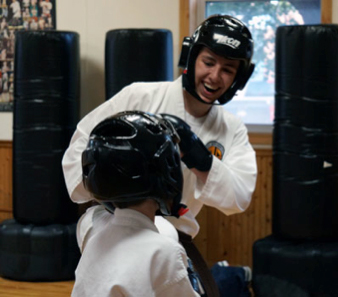 How important are co-curricular activities and volunteer work?
How important are co-curricular activities and volunteer work?
I am proud to have earned a black belt in karate. It took many years of hard work and dedication. A black belt’s duty is to help others learn and master the art, so I have assisted a weekly class where I led the warm-up and basics and individually assisted students when they were struggling.
My passion for politics began when I was selected to serve a term of duty as a legislative page. I [stayed with] an aunt who lived in Toronto and I spent a month of the school year at Queen’s Park. We would fetch glasses of water, make photocopies or run messages for the MPPs. I hadn’t known much about how politics worked previously and this gave me a first-hand view of the process.
At age 14, I decided to get involved with the local riding associations and volunteered hundreds of hours in preparation for both federal and provincial elections. I found it very rewarding serving the community through canvassing, helping disabled and elderly citizens, and acting as an election scrutineer. I have remained heavily involved in politics and am the youngest person ever to be elected to both the federal and provincial conservative riding associations’ board of directors.
Any plans for the future?
An engineering degree is the best possible undergraduate degree for someone with my interests to obtain. Ultimately I would like to earn a graduate degree. I may end up working in the engineering field, but law and politics are also possibilities.
